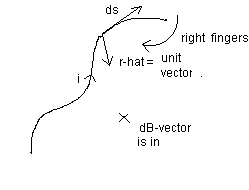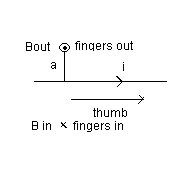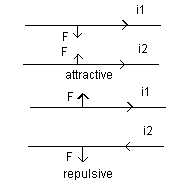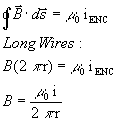|
Related Lab: B-Plot |
| Chapter
Summary: (a)
Use RHR . Wrap r-hat into ds-vector with your right fingers. Thumb points in, like the dB-vector. (b) RHR for long wires.
(c) Force between 2 wires.
(d) Ampere's Law
Use RHR for long wires under (b) above ! |
| 2. Take out your bookmarks, and
compare fig. 30.4 in Ex. 30.2 and fig. P30.2. Also use eqn. 30.3 as a
reference. The magnetic field contributions due to the straight elements are zero because
the ds-vector is parallel to the r-unit vector. That is, On the other hand, each element along the arc gives a dB-vector that points into the paper at P. Note that at every point on this arc, the ds-vector is perpendicular to the r-unit vector. Thus, Thus, Note that in the above expression, one power of r cancels. (See ex. 30.2) Integrate this expression with respect to the angle over the appropriate range. (What is the range of the angle for this arc?) Also, state the direction of the net B-vector. |
| 11. Study fig. P30.11 This problem is virtually
identical to problem 2. That's why I assigned it ! So you can get practice ! So you won't
be surprised should such a problem appear on the final exam !! Using the same arguments as
in the previous problem, we get that: Integrate this expression with respect to the angle over the appropriate range. (What is the range of the angle for a quarter-circle ?) Also, state the direction of the net B-vector. |
| 16. Please do this problem assuming that the two currents are in the opposite direction (anti-parallel), in contrast to the example from sec. 30.2 in class where the currents were parallel. In the case of anti-parallel currents, do the wires attract or repel? Review your notes. |
| 17. Study fig. P30.17. Point your right
thumb in the direction of the current in the long wire, which is upward in the
figure. Note that your right fingers point into the page on the side of the long
wire where the rectangular loop is positioned. Thus the B-field due to the long wire is in.
Consider the top and bottom segments of the rectangle. For the top, the L-vector points to the right. Take the cross product, Here, the subscript t represents "top." The B-vector points in. The L-vector points right. Wrapping the L-vector into the B-vector, you see that your thumb points upward. Performing a similar procedure on the bottom segment, your will see that your thumb points down. Thus, we see that the two forces cancel out. Now consider the force on the side of the
rectangle parallel with and closest to the long wire. Now consider the force on the side of the rectangle parallel with and farthest
from the long wire. Along this segment of the rectangle: Calculate the difference in the magnitudes of the two forces to get the net force. What
direction does the net force point ? Left or right ? |
| 21. From Ampere's law, the value of the magnitude of
the magnetic field at point A is given by: Here the current is the net current flowing through the area of the circle of radius 1 mm. The current is 1 A, out of the page. This is the current in the inner conductor. To find the direction of the magnetic field, point your thumb out of the page, in the direction of the current. Clearly, your right fingers will wrap in the counterclockwise direction. This means that at point A, the B-field points up. At point B:
|
| SP1. Redo example 30.4 . Assume that the wire radius R
= 1.0 m and that the total current = 1.0 A. Assume that the current points out of
the page. Calculate the magnitude and direction (CCW or CW) of the B-vector at: (a) r = 0.5 m (b) r = 2.0 m. |



